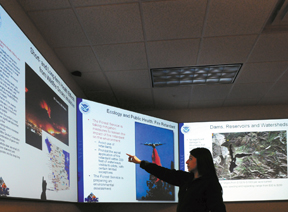
While emergency response groups from all over the country converged to fight the recent wildfires in California, a small group of people at Sandia and Los Alamos were placed on 24/7 operational status, supplying critical information to help decision makers and planners who had to anticipate cleanup and rebuilding activities in the wake of the fires’ devastating effects.
The National Infrastructure Simulation and Analysis Center’s (NISAC’s) core partners are Sandia and Los Alamos national laboratories. Working under the Department of Homeland Security’s Office of Infrastructure Protection (DHS OIP), NISAC uses the labs’ expertise in modeling and simulating complex systems to examine both natural events and disruptions to manmade infrastructure in light of national security issues. Their work allows decision makers to have more robust information before they make critical infrastructure decisions during natural disasters or after a terrorist event.
When events like hurricanes threaten — and sometimes long before — the NISAC team mobilizes to provide planners with projected impacts and consequences; in the case of hurricanes, reports indicating potential vulnerabilities are provided days to hours ahead of landfall. Those areas can be supplied with more emergency resources.
During the wildfires, NISAC’s analysts were pulling together disparate data on everything from ecology and infrastructure surety to potential impacts on housing prices. Their analysis showed how localized interruptions could affect larger regional and national economies and infrastructure systems.
As an increasingly interconnected society, the US relies heavily on its infrastructure systems running smoothly. When an area is disrupted, the consequences to the nation can be surprising and unexpected. Understanding the synergies and interactions among complex systems like public health, ecology, and the economy requires the synthesis and integration of huge sets of data, and often those data sets come from groups that are not accustomed to sharing information.
During an emergency event like the wildfires or a terrorist threat, and sometimes before an anticipated event such as a hurricane, NISAC feeds information to DHS about projected impacts. Catastrophic events have consequences for the economy and for national security that may not be immediately apparent or recognizable.
First responders know the situation on the ground, but they often do not know how local impacts affect the larger infrastructure, and how these impacts cascade, affecting the nation’s economy. Those impacts are not the primary concern of first responders who must deal with more immediate needs like saving lives and protecting property.
NISAC employs experts from a variety of disciplines including systems analysis, computer science, economics, biology, chemistry, the physical sciences, and engineering to examine scenarios of disruption from a variety of viewpoints. The NISAC Fast Analysis and Simulation Team (FAST, led by Nancy Brodsky at Sandia under Theresa Brown, the Sandia NISAC lead) mobilizes people with the requisite expertise; 20-25 Sandians from the Systems Engineering and Analysis business area (6320) and numerous LANL NISAC personnel worked on the wildfire analyses. Each expert contributes his or her analysis to a report provided to those who may respond to such events in the future and to those who must clean up in the aftermath.
During Hurricane Katrina, for example, the NISAC analysis showed that some manufacturers of critical raw materials for the medical supply industry were prevented from distributing their raw materials by blocked transportation routes. If they had been disrupted for too long, shortages of the raw materials could have impacted the availability and safety of medical services nationwide.
During Katrina, NISAC examined issues such as where significant electricity outages might occur and for how long, and where storm surge and power outages could disrupt telecommunications, energy production, or other infrastructure.
In his visit during the NISAC building’s dedication last year, DHS Secretary Michael Chertoff praised the creation of NISAC, stating that “people who have to make decisions need accessible and reliable information.” He praised the “willingness of the Labs to adapt to 21st century challenges and step forward” to address the types of problems that may someday face the nation.